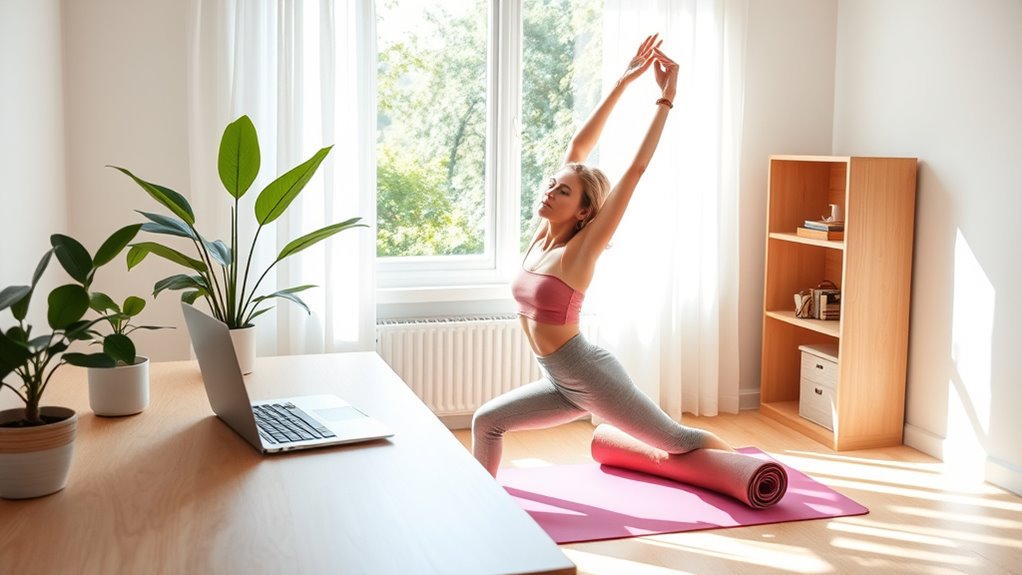To stay active and healthy while working remotely, set timers for regular breaks to stretch or walk around, and incorporate quick exercises like squats or jumping jacks. Guarantee your workspace is ergonomic, with proper chair, desk, and monitor positioning to prevent discomfort. Stay hydrated and choose nutritious meals to fuel your body. Prioritize routine and movement to combat prolonged sitting. Keep exploring these tips to discover more ways to maintain your wellness at home.
Key Takeaways
- Incorporate regular movement by setting timers for stretching and short walks throughout the day.
- Arrange an ergonomic workspace with supportive furniture and monitor at eye level to prevent strain.
- Schedule active breaks with quick exercises like squats or jumping jacks to combat prolonged sitting.
- Stay hydrated and practice mindful eating to maintain energy levels and overall health.
- Use fitness apps or online videos to guide quick, space-friendly workouts and keep motivation high.

Remote work offers flexibility and convenience, but it also presents unique wellness challenges that you need to address. When your home becomes your office, it’s easy for physical activity to fall by the wayside and for your health to suffer. Without the natural movement of commuting or walking between meetings, you might find yourself sitting for hours on end, which can lead to discomfort, fatigue, and even long-term health issues. Recognizing these risks is the first step toward creating a healthier work-from-home routine.
Working from home can lead to decreased activity and health challenges if not managed proactively.
One of the most effective ways to stay active is to incorporate movement into your daily schedule. Set a timer to remind yourself to stand up and stretch every 30 minutes. Simple stretches like neck rolls, shoulder shrugs, and back twists can relieve tension and improve circulation. You might also consider integrating short walks into your day—step outside for a quick 5-minute stroll during breaks or after completing a task. These small movements add up, reducing stiffness and boosting your energy levels.
Creating a dedicated workspace can also promote better physical health. If possible, choose a spot that encourages good posture—an ergonomic chair, a desk at the right height, and a monitor at eye level. When your setup supports proper alignment, you’re less likely to develop neck, shoulder, or back pain. Don’t forget to reposition your workspace regularly; changing your posture throughout the day helps prevent strain and fatigue.
In addition to physical adjustments, establishing a routine that emphasizes movement can make a significant difference. Schedule “active breaks” just like you would meetings or deadlines. Use these moments to do quick exercises like squats, lunges, or even jumping jacks. Not only do these activities break the monotony, but they also stimulate your muscles and improve blood flow. If you find it difficult to motivate yourself, consider using fitness apps or online videos that guide you through quick workouts designed for small spaces.
Hydration plays a vital role in maintaining your wellness. Keep a water bottle nearby and sip regularly throughout the day. Proper hydration supports your energy levels and helps prevent headaches caused by dehydration. Pair this with mindful eating—avoid excessive snacking and opt for balanced meals that fuel your body effectively. Preparing your meals in advance can help you resist the temptation of unhealthy snacks and keep your nutrition on track.
Ultimately, staying active and healthy while working remotely requires intention and consistency. By integrating movement into your routine, optimizing your workspace, and prioritizing hydration and nutrition, you can mitigate the wellness challenges of home office work. Regular physical activity, supported by a growth mindset, can help you stay motivated and committed to your health. Remember, taking small steps today can lead to lasting habits that promote your overall well-being, making remote work not just convenient, but also healthier and more sustainable in the long run.
Frequently Asked Questions
How Can I Prevent Eye Strain During Long Screen Hours?
To prevent eye strain during long screen hours, you should follow the 20-20-20 rule: every 20 minutes, look at something 20 feet away for at least 20 seconds. Adjust your screen brightness to match ambient lighting, and consider using blue light filters or glasses. Keep your workspace well-lit, blink frequently to stay hydrated, and take regular breaks to give your eyes a rest.
What Are Quick Exercises to Do During Breaks?
Imagine feeling energized with just a few quick moves. You can do jumping jacks to get your blood flowing, stretch your arms overhead, or do neck rolls to relieve tension. These exercises take only a minute or two and can boost your focus. When you take these small breaks, you’ll notice your body waking up, making it easier to tackle your work with renewed energy and clarity.
How Do I Set Boundaries to Avoid Overworking?
To set boundaries and avoid overworking, establish clear work hours and communicate them to your team. Use alarms or calendar reminders to signal the start and end of your workday. Create a dedicated workspace, so you mentally switch off when you’re done. Prioritize tasks to prevent burnout, and resist the urge to check emails outside your set hours. Remember, maintaining boundaries helps improve your work-life balance and overall well-being.
What Ergonomic Tools Can Improve My Home Office Setup?
You can improve your home office setup by investing in an ergonomic chair with adjustable height and lumbar support, a sit-stand desk to alternate positions, and an ergonomic keyboard and mouse to reduce strain. Additionally, consider monitor risers to keep screens at eye level and footrests for comfort. These tools help maintain good posture, prevent discomfort, and boost productivity while working remotely.
How Can I Stay Socially Connected While Working Remotely?
Did you know that 70% of remote workers feel lonelier than office workers? You can stay socially connected by scheduling regular virtual coffee chats, participating in online communities, or joining virtual team-building activities. Make it a point to reach out to colleagues, share updates, and celebrate wins. These small efforts help build relationships, reduce loneliness, and keep you engaged, making remote work more fulfilling and less isolating.
Conclusion
Remember, your well-being is the foundation of your productivity. Just as a house needs a strong foundation, your health keeps your work steady and resilient. Prioritize movement, stay hydrated, and set boundaries—your body and mind will thank you. Don’t let the comfort of home become a trap; instead, make it your sanctuary for wellness. After all, your health isn’t just a goal—it’s the very breath of your success.










